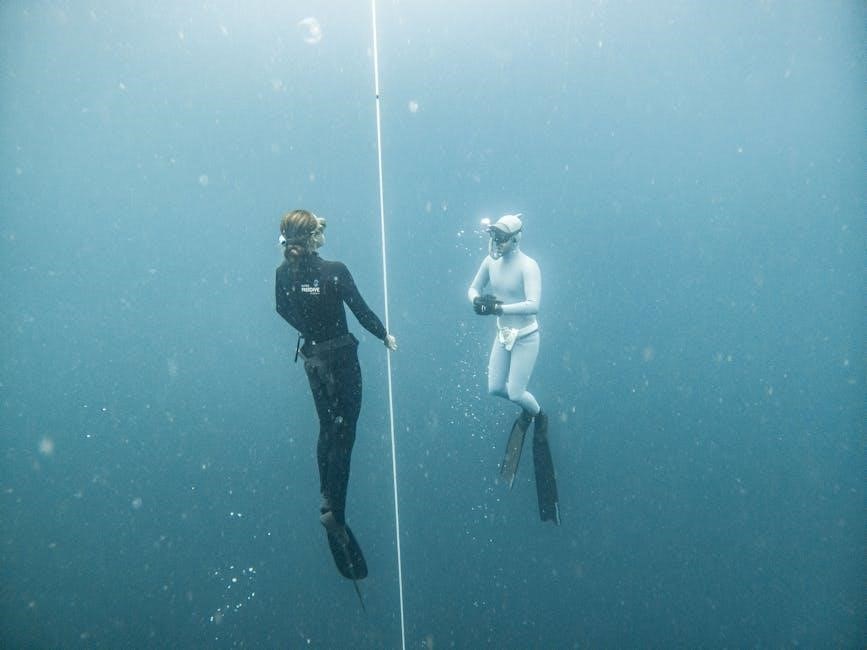A proper-fitting wetsuit is essential for comfort, flexibility, and performance in water sports. This guide helps you navigate size charts, thickness options, and fit preferences to ensure a snug, second-skin feel without restrictions, tailored to your body shape and activity needs.
Why Proper Fit Matters
A properly fitting wetsuit is crucial for optimal performance and comfort in the water. A snug fit ensures minimal water entry, retaining body heat and reducing drag. If the wetsuit is too loose, cold water can flush in, making it less effective at keeping you warm. Conversely, a wetsuit that is too tight can restrict movement and cause discomfort or chafing. Proper fit also enhances mobility, allowing you to move freely during activities like surfing or swimming. A well-fitting wetsuit maximizes its insulating properties while ensuring a full range of motion, making it essential for both performance and enjoyment in water sports.
Understanding Wetsuit Size Charts
Wetsuit size charts provide detailed measurements to help you find the perfect fit. They typically include height, chest, and waist measurements, along with weight ranges. Men’s, women’s, and youth charts differ, as body proportions vary by gender and age. For example, men’s charts often list sizes like XS, S, M, L, and XL, with corresponding height and chest measurements. Women’s charts may include additional considerations like body shape. Youth sizes focus on growth stages, offering smaller increments. EU and US size comparisons are also common. These charts ensure the wetsuit fits snugly, balancing comfort and performance. Proper fit is crucial for insulation, mobility, and overall satisfaction during water activities.

Men’s Wetsuit Size Chart
Men’s wetsuit sizes range from XS to XXL, with measurements based on height, chest, and waist. Sizes like ST, MS, and MT cater to different body types and preferences.
Height and Weight Correlations
For men, wetsuit sizing closely aligns with height and weight measurements. Typically, taller individuals require larger sizes, while shorter individuals fit smaller sizes. For example, a height range of 169-188 cm (5’6″-6’2″) corresponds to weights between 64-77 kg (140-170 lbs), depending on the brand. ONeill’s size chart illustrates this correlation, with sizes like ST (60-62) catering to taller and heavier builds, while MS (56.5-58.5) suits shorter and lighter frames. These measurements ensure a balanced fit, accommodating both height and weight proportions. Always refer to the specific brand’s chart, as slight variations may occur.
Chest and Waist Measurements
Chest and waist measurements are critical for determining a wetsuit’s fit. A snug chest fit ensures warmth and prevents water entry, while the waist should be comfortable without restriction. For men, sizes range from XS to XXL, with chest measurements typically spanning 88-110 cm (34-43 in) and waist measurements ranging from 68-98 cm (27-39 in). For example, ONeill’s size chart shows that an MS size corresponds to a chest of 97-102 cm (38-40 in) and a waist of 77-82 cm (30-32 in). Proper measurement ensures the wetsuit feels like a second skin, providing both flexibility and insulation. Always use a flexible tape measure for accuracy and refer to the brand’s specific sizing guidelines for the best fit.
EU and US Size Comparisons
EU and US wetsuit sizes often differ, so comparing them is essential for the right fit. Generally, EU sizes are slightly smaller than US sizes, meaning a US Medium might align with an EU Large. For example, a US size Medium typically corresponds to an EU size 42-44, while a US Large matches an EU 46-48. However, this can vary by brand, so always check the specific size chart. Chest and height measurements are key to accurate sizing. If you’re between sizes, consider personal fit preferences. Brands often provide dual sizing charts, so refer to their guidelines for the most accurate comparison and to ensure the best fit for your body type and activity needs.

Women’s Wetsuit Size Chart
A women’s wetsuit size chart tailors fits to body shape, height, and weight, ensuring comfort and flexibility for water activities. Proper sizing enhances performance and warmth retention.
Body Shape Considerations
Women’s body shapes vary, and wetsuits must accommodate these differences for optimal fit. Petite frames require shorter lengths and narrower cuts, while taller women benefit from longer torsos. Hourglass figures need wetsuits with flexible mid-sections, ensuring comfort without restriction. Athletic builds may prefer streamlined designs for better mobility, while plus-size options focus on supportive fits without compromising flexibility. Chest, waist, and hip measurements are crucial, as they determine how the wetsuit hugs the body. Proper alignment ensures even distribution of neoprene, preventing bunching or tight spots. Considering body shape ensures the wetsuit moves naturally with the body, enhancing performance and comfort in the water.
Height and Weight Guidelines
Height and weight are critical factors in determining the right wetsuit size; Generally, taller individuals require wetsuits with longer torsos, while shorter individuals need shorter lengths to avoid excess material. Weight helps estimate girth, ensuring the wetsuit fits snugly without being too tight or loose. For men, height and weight correlations are often aligned with chest measurements, while for women, hip and bust measurements play a larger role. Youth sizes focus on growth stages, balancing height and weight for a comfortable fit. By combining height and weight data, wetsuit size charts provide a starting point, though other factors like body shape and activity type may refine the choice. Proper alignment ensures optimal performance and comfort in the water.
Inch and Centimeter Conversions
Accurate measurements are key to selecting the right wetsuit size, and understanding inch to centimeter conversions is essential, especially for international shoppers. Most wetsuit size charts include both inch and centimeter measurements to accommodate global standards. To convert inches to centimeters, multiply the inch measurement by 2.54. For example, a 38-inch chest measurement equals 96.5 centimeters. When measuring yourself, use a flexible tape measure and ensure accuracy by standing up straight and keeping the tape measure level. Double-checking your measurements and comparing them to the size chart will help you find the perfect fit. Precise conversions ensure comfort, flexibility, and optimal performance in the water.

Wetsuit Size Chart for Youth
Youth wetsuit sizes are based on age, height, weight, and chest measurements, ensuring a comfortable fit for growing bodies. Charts cater to varying body proportions in children.
Age and Height Correlations

Youth wetsuit sizes are primarily determined by age and height, as these factors help estimate body proportions. Typical age ranges for youth sizes are 6–14 years, divided into small, medium, and large categories. Height plays a crucial role, with sizes correlating to specific height ranges, ensuring the wetsuit fits comfortably without being too tight or loose. For example, a size small might suit a child around 4’–4’6″, while a medium fits heights of 4’7″–5′, and large accommodates 5’1″–5’4″. These correlations provide a starting point, but actual measurements should always be checked for accuracy. Proper fit ensures mobility and comfort during water activities.
Weight and Chest Measurements
Accurate weight and chest measurements are essential for selecting the right youth wetsuit size. Chest size determines how the wetsuit fits around the torso, ensuring it’s snug but not restrictive. Weight helps estimate overall size, especially when combined with height. For example, a child weighing 70–80 lbs with a chest measurement of 28–30 inches might fit a medium size. These measurements align with standard youth sizing charts, which cater to growing bodies. While age provides a general guide, actual measurements ensure the best fit. Always use a flexible tape measure to get precise readings, as proper fit is key to comfort and performance in the water.
Size Options for Growing Bodies
Youth wetsuits are designed with growth spurts in mind, offering flexible size options to accommodate changing bodies. Many brands provide adjustable features, such as longer sleeves and torsos, to extend the wetsuit’s lifespan as children grow. High-quality neoprene ensures durability, withstanding the wear and tear of active use. Some models include removable layers or expandable panels to adapt to increasing sizes. Reinforced stitching and stretchy materials ensure a snug yet comfortable fit, even as kids grow taller and stronger. These designs balance durability and flexibility, making them a practical choice for families. Proper fit is crucial for comfort and performance in water activities, ensuring youngsters enjoy their time in the ocean or pool.

How to Measure Yourself for a Wetsuit
Use a flexible tape measure to determine height, chest, waist, and weight. Stand straight, measure over thin clothing, and ensure the tape isn’t too tight or loose.
Measuring Height Accurately
Accurate height measurement is crucial for a proper wetsuit fit. Stand straight against a wall with feet flat and shoulders relaxed. Remove shoes to avoid adding extra height.
Use a pencil to mark the top of your head on the wall. Measure this distance with a tape measure or ruler. Ensure the measurement is precise,
as even small discrepancies can affect the fit. Avoid slouching or bending, as this can lead to incorrect sizing. For the best results, have someone assist you.
This ensures the measurement is taken correctly and consistently. Proper height alignment helps determine the ideal wetsuit length, preventing discomfort or restricted movement.
Taking Chest and Waist Measurements
Accurate chest and waist measurements are essential for a well-fitting wetsuit. To measure your chest, stand upright and wrap a flexible tape measure around the fullest part of your chest, keeping the tape level and parallel to the floor. Ensure the tape isn’t too tight or too loose. For the waist, locate your natural waistline, typically just above your belly button, and measure around it with the tape measure straight and snug but not restrictive. These measurements help determine the wetsuit’s fit around your torso, ensuring comfort and flexibility. Consistency is key, so take measurements without bulky clothing and consider having someone assist you for accuracy.
Ensuring Proper Fit Without Restrictions
A proper wetsuit fit ensures unrestricted movement while maintaining necessary compression for warmth and performance. The wetsuit should feel snug but not overly tight, allowing full range of motion in the shoulders, arms, and groin. Avoid sizes that cause bunching or restriction, as this can impede flexibility and comfort. After putting on the wetsuit, stand naturally and check if it feels balanced across your torso. If it feels too tight, consider a larger size, and if it feels loose, opt for a smaller one. Proper fit ensures optimal performance and comfort during water activities. Remember, a wetsuit should feel like a second skin, providing support without limiting movement.

Wetsuit Thickness Guide
A wetsuit’s thickness determines its insulating properties, with options ranging from 2mm to 7mm. Thicker suits are ideal for colder waters, while thinner suits suit warmer conditions. Choose based on water temperature and activity needs for optimal performance.
Understanding Thickness Options
Wetsuit thickness plays a crucial role in determining insulation, flexibility, and durability. Common measurements range from 2mm to 7mm, with variations like 3/2mm or 4/3mm for Layered suits. Thicker suits (5mm-7mm) are ideal for cold water, offering maximum warmth but less flexibility. Medium thickness (3-4mm) balances warmth and mobility, suitable for temperate waters. Thin suits (2mm) prioritize flexibility, best for warm conditions. The choice depends on water temperature, activity level, and personal preference. Proper thickness ensures comfort and performance without compromising movement. Always consider your specific needs to select the right thickness for optimal wetsuit functionality.
Water Temperature and Thickness Recommendations
Choosing the right wetsuit thickness depends on water temperature. For warm waters (above 72°F/22°C), a 2mm or 2/1mm suit is ideal, offering flexibility and minimal insulation. In temperate waters (64°F-72°F/18°C-22°C), opt for 3/2mm or 4/3mm thickness for a balance of warmth and mobility. Colder waters (58°F-64°F/14°C-18°C) require 4mm or 5/4mm suits for better insulation. For very cold or freezing waters (below 58°F/14°C), choose 6mm or 7mm suits to maximize warmth. Always consider personal comfort, wind, and sun exposure when selecting thickness. Proper alignment of thickness with water temperature ensures optimal performance and comfort during your water activities.

Additional Factors in Choosing the Right Size
Consider body type, personal fit preferences, and activity-specific needs. Different body shapes may require tailored fits, while activities like surfing or diving demand varying flexibility and warmth levels.
Body Type and Fit Preferences
Body type plays a significant role in selecting the right wetsuit size. Ectomorphs, mesomorphs, and endomorphs have unique needs. For example, broader chests or longer torsos may require specific cuts. Fit preferences also vary; some prefer snug, performance-oriented suits, while others prioritize comfort and flexibility; Personal comfort is key, as a wetsuit that feels restrictive can hinder movement and enjoyment. Additionally, body proportions, such as longer limbs or shorter waists, may necessitate custom or tailored options. Understanding your body type and fit preferences ensures a wetsuit that balances performance, comfort, and mobility, enhancing your overall experience in the water.
Activity-Specific Sizing Tips
Different water activities demand tailored fits for optimal performance. Surfers often prefer a slightly looser fit for flexibility, while divers may opt for a snugger suit to maintain warmth. For swimming or triathlons, a streamlined fit minimizes drag and enhances mobility. Consider the movement requirements of your sport—paddling, diving, or swimming—and choose a wetsuit that balances flexibility with support. For high-intensity activities, ensure the suit allows full range of motion without restricting limbs. Additionally, water temperature and session duration influence thickness preferences. Always align your wetsuit choice with the specific demands of your activity to maximize comfort and performance.

How to Use a Wetsuit Size Finder
To use a wetsuit size finder, visit the retailer’s website, select your gender, and input accurate height, weight, and chest measurements.
Choose your activity type and preferred fit style.
Review the recommended size and compare it with the size chart for confirmation.
This tool ensures a precise fit tailored to your needs.
Step-by-Step Guide to Using Online Tools
To use a wetsuit size finder, start by accessing the tool on the retailer’s website.
Enter your gender and input accurate measurements, including height, weight, and chest circumference.
Select your activity type, such as surfing or diving, and choose your preferred fit style—tight, medium, or loose.
Submit the information and review the recommended size.
Compare the result with the brand’s size chart to ensure consistency.
Some tools may also ask for additional details like waist size or body type for better accuracy.
Double-check your measurements to avoid errors.
Finally, use the suggested size to place your order confidently.
This process ensures a personalized fit tailored to your needs and preferences.
Interpreting Size Finder Results
Once you’ve used an online wetsuit size finder, carefully review the results to determine your ideal size.
The tool will typically display a recommended size based on your measurements and preferences.
Pay attention to any additional details provided, such as fit style (tight, medium, or loose) or thickness options.
Some size finders may also show a size chart for comparison.
If multiple sizes are suggested, consider your activity and body type to make the best choice.
Ensure the recommended size aligns with your comfort and performance needs.
If unsure, refer to the brand’s sizing guide or contact customer support for clarification.
This step ensures you select a wetsuit that fits perfectly and meets your requirements.

Common Mistakes to Avoid
Ignoring body shape differences and activity-specific needs are common errors.
Not measuring accurately or assuming sizes across brands leads to poor fits.
Avoid these pitfalls for optimal comfort and performance.
Overlooking Body Shape Differences
One of the most frequent mistakes is not considering individual body shapes when choosing a wetsuit.
Body types vary significantly, from athletic builds to slim or broader frames.
Ignoring these differences can lead to a wetsuit that is too tight or too loose.
Tight wetsuits restrict movement, while loose ones reduce warmth and performance.
Always review size charts and look for brands that cater to your specific body type.
For example, some brands offer tailored fits for broader shoulders or longer torsos.
Take the time to measure accurately and compare your dimensions to the chart.
Remember, a proper fit ensures both comfort and optimal performance in the water.
Not Considering Activity-Specific Needs
Another common mistake is failing to account for the specific demands of your water activity.
Different sports, such as surfing, diving, or triathlons, require varying levels of flexibility and insulation.
A wetsuit designed for one activity may not perform well for another.
For instance, a surfing wetsuit prioritizes flexibility, while a triathlon wetsuit focuses on reducing drag.
Ignoring these differences can lead to discomfort or subpar performance.
Always consider the primary use of your wetsuit and choose a model tailored to your activity.
Check the manufacturer’s guidelines for activity-specific sizing and features.
This ensures the best combination of mobility, warmth, and durability for your needs.
Remember, the right fit enhances both comfort and performance in the water.
Choosing the right wetsuit size ensures comfort, flexibility, and performance in the water.
By following this guide, you’ll find the ideal fit for your body and activity.
Invest time in measuring and selecting wisely for an enhanced experience.
Final Tips for the Perfect Fit
Ensuring a perfect wetsuit fit is crucial for optimal performance and comfort.
Always prioritize how the suit feels on your body, as sizes can vary between brands.
Try wetsuits on if possible, and pay attention to flexibility and mobility.
Don’t compromise on fit—tightness restricts movement, while looseness reduces warmth.
Consider personal preferences, like thickness for cold water or seamless construction for sensitivity.
Lastly, double-check measurements and reviews to confirm your choice aligns with your needs.
A well-fitting wetsuit enhances your experience in the water.
Ensuring Comfort and Performance
A well-fitting wetsuit is essential for both comfort and performance in water activities.
It should allow for a full range of motion without feeling restrictive.
A snug fit ensures warmth and prevents water from entering the suit excessively.
The right thickness for your water temperature is crucial—thicker suits for colder waters and thinner for warmer conditions.
High-quality materials and seamless construction enhance durability and reduce chafing.
Activity-specific features, like reinforced knees for surfers, can improve longevity.
Proper layering, such as wearing a rash guard underneath, prevents friction.
Always check size charts and reviews to confirm your choice meets your needs.
A perfect fit ensures confidence and peak performance in the water.